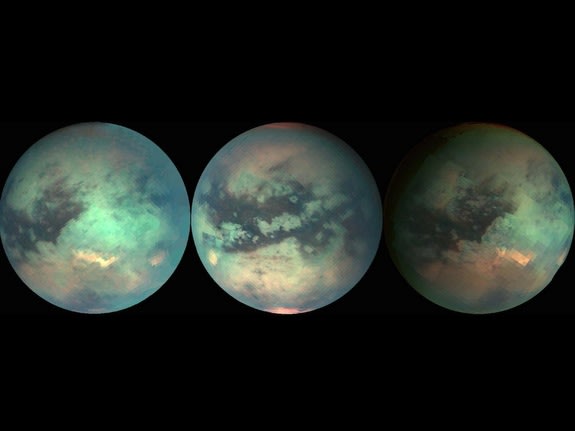 Mosaics composed with data from the Cassini spacecraft taken during three separate Titan flybys.
Mosaics composed with data from the Cassini spacecraft taken during three separate Titan flybys.
Intriguing new research shows that liquid water may not be a must-have ingredient for life in the universe, and that strange new lifeforms may be lurking in distant, much colder worlds at the edge of the solar system — and beyond.
A new study coming out of Cornell University published this past week in the journal Science Advances gives us our first tantalizing hints that life may not need to be based on water-chemistry, but could be based on liquid methane instead. And it turns out that Saturn’s largest moon, the methane-sea covered Titan, fits the bill perfectly (at least theoretically).
A team of chemical engineers and astronomers looked at how the nitrogen-based chemistry on this distant world may be just right to form cell membranes that could, in theory, function in the minus 292 degrees temperatures found on the surface of this smoggy moon.
“It is possible to construct structural analogs to terrestrial bio-membranes that may work in the Titan environment, and it also demonstrates the flexibility of chemistry in making structures that could function for biochemistry in an exotic environment,” said co-author and astronomer Jonathan Luninein an interview with Yahoo Canada News.
“We are providing possibilities only, based on molecular simulations and knowledge of the Titan environment.”
If these findings were able to be proven, it would mean that we must expand our search for life too beyond the much-talked about Goldilocks Zone, which is the region around a star where a planet must orbit and have liquid water exist.
Since methane exists at a much lower freezing point, this potential habitable zone around stars that we consider in searching for life would be a much broader zone than anything we had been considering before now.
Besides Titan, there are other possible places where liquid hydrocarbon abounds within our solar system worth looking for this new possible life form too.
Besides Titan, there are other possible places where liquid hydrocarbon abounds within our solar system worth looking for this new possible life form too.
“So far, Titan seems to be the only locale in our solar system where methane is stably a liquid on the surface,” said Lunine.
“But one perhaps should not rule out liquid methane/ethane within the subsurfaces of [Neptune’s moon] Triton and Pluto.”
Of course the ultimate test would be to go to Titan and attempt to hunt for these exotic forms of life on its surface.
NASA already has on its drawing boards just such an ambitious mission it calls the Titan Mare Explorer (TiME) it would like to launch within this decade.
The TiME capsule would launch and reach Titan in about 7 years, parachuting onto the moon’s second-largest northern sea, the Ligeia Mare.
For three months the capsule would study the composition and behavior of the methane sea and its interaction with Titan’s weather and climate. TiME would also seek evidence of the complex organic chemistry that may be active on Titan today. Of great interest to scientists is the possibility that today’s environment may be similar to processes that led to the development of life on the early Earth.
“This Discovery mission concept proposed a few years ago to land on and inspect a Titan sea, would be an excellent platform from which to sample the sea and search for structures like what we are modelling,” Lunine added.
There is no doubt in Lunine’s mind that his team’s finding could one day very well impact our search for life in the cosmos.
These intriguing results tell us that we need to be creative in thinking about what physical environments permit the natural development of structures at the molecular level that could evolve chemistry across the threshold of biology, says Lunine.
“We have one example of life—aqueous, DNA-encoded life—and there are several intriguing environments in the solar system where such life might also exist today, like Europa, Enceladus, Mars, but there are other environments accessible to us where exotic biochemistries might exist, like Titan,” he added.
“We have the capability to explore all of them—let’s go!”







No comments :
Post a Comment